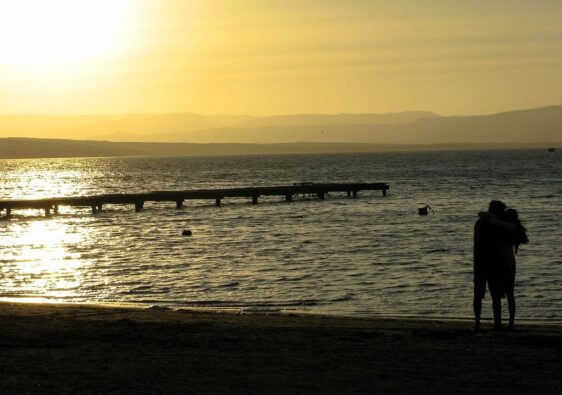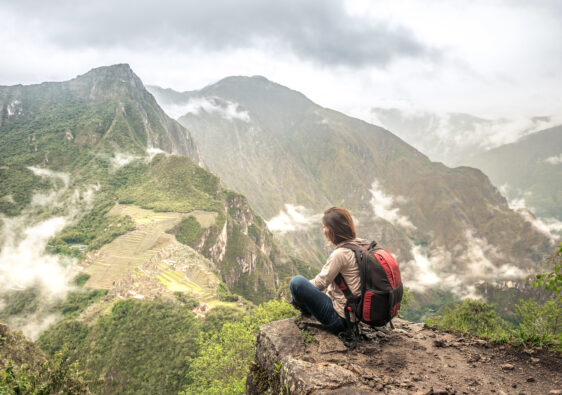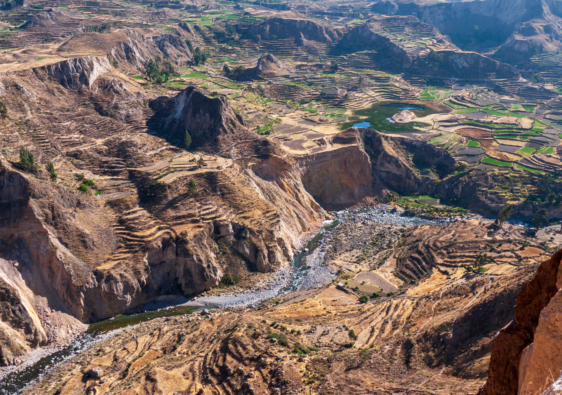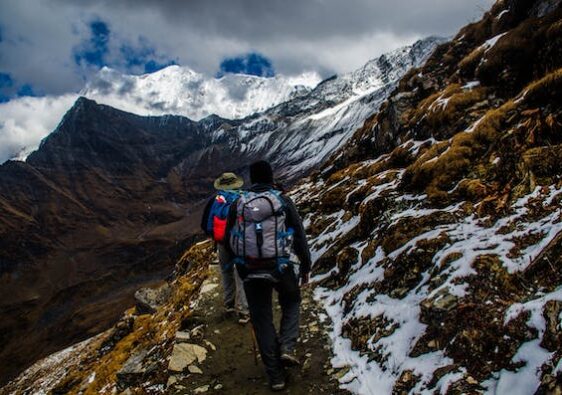Nestled within the Cusco Region of Peru, the Rainbow Mountain Peru, or Vinicunca, emerges as a breathtaking spectacle and a fast-growing tourist attraction celebrated for its myriad of colors that adorn the Peruvian Andes. Its surface, boasting a vibrant palette including pinks, reds, greens, blues, yellows, and browns, is a visual testament to the unique mineralogical composition of the area, making Vinicunca a revered international attraction and one of the most colorful mountains in the world. Uncovered only in 2013 after the melting of its concealing snow cover, Vinicunca reveals story millions of years in the making, where the interaction of various minerals painted this masterpiece, now known for its impressive Rainbow Mountain altitude of 5,200m above sea level.
This guide to Vinicunca Peru, also known as the Vinicunca Mountain Peru or Vinicunca Rainbow Mountain Peru, unfurls the history, geographical allure, and the exhilarating adventure of hiking the trail. From the mountain’s geological wonders to the cultural significance rooted in Quechua heritage, each segment offers visitors an in-depth understanding of Vinicunca’s magnificence. Key insights into the best times to visit, conservation efforts, and nearby attractions will equip travelers with all they need to embark on this unforgettable journey through one of the Rainbow Mountains of Peru, a truly iconic landscape.
Geographical Location and Access
Rainbow Mountain Peru, or Vinicunca, is a striking natural wonder located in the heart of the Peruvian Andes, within the Cusco region. Access to this colorful mountain is regulated to ensure its preservation and to manage the impact of tourism. Here’s a detailed look at how to reach and experience Rainbow Mountain Peru:
Accessing Rainbow Mountain Peru
- Official Tour Companies: The mountain is accessible exclusively through official tour operator partners that hold the necessary permissions for organizing tours to this unique destination. This approach ensures a controlled number of visitors, which is essential for the conservation of the site’s natural beauty.
- Location and Proximity: Situated about 100 kilometers south of Cusco, in the Cordillera del Vilcanota, Rainbow Mountain stands at an impressive altitude of 5,200 meters above sea level. It’s nestled between the provinces of Quispicanchi, Pitumarca, and Canchis, making it a part of the breathtaking Andean landscape.
Getting There
- From Cusco to Rainbow Mountain
- By Private Transfer: The most convenient, albeit expensive option, involves a roughly 3-hour journey via Hwy 3S and Hwy 124, passing through Checacupe, often facilitated by a tour operator.
- By Bus and Taxi: A more budget-friendly alternative includes taking a bus from Av. Tomasa Tito Condemayta near the Tupac Amaru hospital in Cusco to Checacupe, followed by a taxi to the Rainbow Mountain hike start point, a journey that can span 3-4 hours and is sometimes arranged by tour operators.
- Trekking to the Summit
- The adventure begins at a trailhead in the town of Pitumarca, where climbers embark on a 3 to 4-hour trek to reach the summit of Rainbow Mountain. The trail offers breathtaking panoramas of the Andes mountains, showcasing the majestic Cordillera Vilcanota and the towering Nevado Ausangate massifs.
Preparing for Your Visit
- Acclimatization: Due to the high altitude, visitors are advised to spend at least a day in Cusco to acclimatize and reduce the risk of altitude sickness.
- Essentials: When preparing for the ascent, pack warm clothing, food, extra money, trekking poles, and coca leaves to aid with the challenges of climbing at high altitudes.
- Transportation Options: While traveling to Cusco from Lima, the Peru Hop bus is the preferred mode of transportation for gradually adjusting to the higher elevations. However, for those pressed for time, flying remains an option, albeit with a heightened risk of altitude sickness.
By following these recommendations and careful planning, visitors can ensure a memorable and secure expedition to one of Peru’s most renowned natural attractions, the illustrious Rainbow Mountain Peru.
Historical Background
Vinicunca, more popularly known as Rainbow Mountain Peru, was shrouded in mystery and hidden from the world’s eyes under a thick blanket of snow and ice until a significant shift in climate patterns led to its revelation in 2013. This extraordinary transformation from an unseen marvel to one of the most iconic natural wonders in Peru was not just a testament to the changing global climate but also marked the beginning of a new chapter in the mountain’s history. The unveiling of Rainbow Mountain’s striking colors, a result of mineral deposits, quickly catapulted it to fame, securing a coveted spot in National Geographic’s “Top 100 Places to Visit Before You Die”.
Discovery and Popularity:
- 2013: Revealed to the global community due to receding glaciers and snow cover.
- 2015: Gained international attention through viral photos taken by tourists hiking the adjacent Ausangate mountain.
- Included in National Geographic’s prestigious list for travelers, underscoring its rapid rise in popularity.
Cultural and Historical Significance:
- Known to local communities for centuries, the mountain holds deep cultural significance, particularly to the Quechua people who consider it sacred, referring to it and other significant peaks as “Apu”, a term denoting reverence and mystical powers, reflecting the rich local culture.
- The Star Snow festival, an annual pilgrimage by thousands of Quechua people to Vinicunca, highlights the enduring cultural importance and spiritual connection the local communities have with the mountain.
The narrative of Rainbow Mountain is a compelling mix of recent discovery and ancient reverence. While its physical appearance changed dramatically in a relatively short period due to environmental factors, the mountain’s significance has remained constant in the hearts of those who have known it for generations. The juxtaposition of its recent global fame against its longstanding cultural importance paints a vivid picture of a natural wonder that continues to captivate and inspire both locals and travelers alike.
Geological Wonders

Rainbow Mountain, a geological marvel nestled in the Andes of Peru, owes its breathtaking palette to a complex interplay of minerals and geological processes. The mountain’s vivid stripes and hues can be attributed to the following mineral compositions:
- Pink or Fuchsia: A blend of red clay, mudstone, and sand, enriched with iron oxide that lends the mountain its pinkish hue.
- White: The stark white stripes that adorn the mountain are primarily composed of sandstone (quartz sand) and limestone, materials that reflect light and contribute to its status as a natural formation.
- Purple or Lavender: Marlstone, which is a mixture of clay and calcium carbonate, along with silicates, contributes to the purple or lavender shades seen on the mountain.
- Red: The presence of argillites and clays, rich in iron, accounts for the vibrant red sections that stand out against the mountain’s backdrop.
- Green: Clays rich in ferromagnesian minerals (iron and magnesium) along with copper oxide, give the mountain its green streaks.
- Yellowish Brown, Mustard or Golden: These colors are the result of limonites and calcareous sandstones that are rich in sulfur minerals, adding a golden glow to the mountain’s spectrum.
- Earthy Brown: Contributing to the mountain’s earthy brown sections are fanglomerates composed of manganese rocks from the Quaternary era, reflecting the diverse mineralogical composition that shapes its appearance.
The geological timeline of Rainbow Mountain extends back some 24 million years. The colors we marvel at today are the result of a long history of oxidation and erosion, processes that have gradually exposed the mineral-rich layers beneath the surface. Volcanic and tectonic activities have played a pivotal role in shaping the mountain’s unique coloration, pushing the mineral-rich earth upwards and creating the rainbow-like patterns observed today.
The interaction between these minerals and the environment has been a dynamic process. The humidity of the area and erosion over time have further influenced the oxidation of minerals, enhancing the mountain’s vibrant hues. This natural spectacle, resulting from millions of years of geological activity, has not only painted an unimaginable color palette but also offers a glimpse into the earth’s history, making Rainbow Mountain a destination of curiosity and admiration among adventurers and nature lovers alike.
Hiking to Rainbow Mountain

Embarking on the hike to Rainbow Mountain Peru, officially known as Vinicunca, is an adventure that requires preparation and respect for the natural elements, offering a journey through some of Peru’s most stunning landscapes. The trek is recognized for its breathtaking vistas and the unique opportunity to immerse oneself in the vibrant hues of the mountain. However, the high altitude presents challenges that hikers need to prepare for. Here’s a detailed guide to maximizing the experience while ensuring safety and enjoyment:
Preparation and Acclimatization:
- Acclimatization: Spend a few days in the Cusco region to adjust to the high altitude. This step is crucial to minimize the risk of altitude sickness, which can affect anyone regardless of fitness level.
- Packing Essentials: Bring a water bottle, snacks, Peruvian soles in smaller bills, comfortable hiking shoes, a warm hat, multiple layers of clothing, sunscreen, sunglasses, a camera, and, importantly, coca leaves to help with altitude. An oxygen tank is also recommended, as not all tour operators provide one.
- Weather Preparedness: Regardless of the season, weather can change dramatically. Dress in layers, and be prepared with rain gear and winter gear if hiking during the wet season. The best weather for trekking is between March and November, with blue skies most likely from June to August.
The Hike Itself:
- Starting Early: To sidestep the crowds, consider an early departure from Cusco at 3 am with a reputable tour operator like AB Expeditions, known for their early starts. Starting the trek around 11 am is advised to avoid larger tour groups and enjoy a more serene experience on Rainbow Mountain.
- Trail Difficulty and Options: The climb to Rainbow Mountain is rated as fairly difficult, with a 3 to 4-hour trek to the outlook. For those who find the altitude daunting, renting a horse for the flatter sections is a viable option, though not for the final ascent.
- Fees and Guidelines: As you ascend the mountain, a modest 10 soles entrance fee is required, a small contribution supporting tourism in Peru and the conservation efforts of the region. To maintain the area’s rich biodiversity and ecological balance, visitors are encouraged to stay on the designated trails.
At the Summit:
- Once at the summit, Cerro Vinicunca offers time for photos and views of the glacier-capped mountain of Ausangate. The journey doesn’t have to end at Vinicunca; consider the Short Inca Trail to Machu Picchu or the Ausangate Trek for more extensive exploration
This trek is an unforgettable adventure that can be enjoyed by most with the right preparation, offering not just a physical challenge but also an opportunity to connect with nature’s extraordinary beauty. Remember, the journey to the mountain is as amazing as the destination itself, with llamas, horses, and alpacas dispersed throughout the area, enriching the experience.
Best Times to Visit
When planning your visit to the breathtaking Rainbow Mountain Peru, timing is everything to secure the most favorable experience. Here’s an insight into the best periods for visiting, considering weather patterns, crowd sizes, and overall conditions, to optimize your journey in Peru.
Optimal Months for Weather Conditions
- Dry Season (Best Weather): April through November, with May to September being particularly ideal.
- Peak Visibility Months: July and August are the sunniest, offering clear views of the mountain’s vibrant colors.
- Shoulder Seasons: For those seeking tranquility and mild weather, late April, May, September, October, and early November are the optimal months to explore Peru’s less crowded trails and enjoy comfortable temperatures.
Avoiding the Crowds
- Least Busy Time: The rainy season, spanning from November to March, marks the lowest tourist times in Peru, presenting an opportunity for visitors to experience the attractions with fewer crowds and a more personal connection to the natural wonders.
- Busiest Months: June, July, and August align with the northern hemisphere’s summer, drawing the largest influx of visitors to Peru, making these months the peak season for tourism.
- Daily Timing: For those interested in tours, it’s best to visit between 7-9 am or after 2 pm to avoid the crowds. The serene early mornings around sunrise, from 7:00 am to 11:00 am, offer a particularly peaceful experience.
Months and Times to Avoid
- Rainy Season: February experiences the peak of the rainy season, leading to challenging hiking conditions.
- Worst Month for Hiking: January, especially late January, is known for intense rain, landslides, and poor visibility.
- Crowded Days: Sundays tend to be more crowded with locals and Peruvians, making weekdays a better option for those seeking solitude.
This guide aims to help visitors choose the best time for their adventure to Rainbow Mountain Peru, balancing weather conditions, crowd sizes, and personal preferences for an unforgettable experience.
Conservation Efforts

Despite its breathtaking beauty and increasing popularity, Rainbow Mountain, or Vinicunca, currently lacks official protection by the government, leaving it susceptible to the impacts of human activity. Recognizing the urgent need for preservation, several initiatives and proposals have been put forward:
- Proposed Conservation Area: In a collaborative effort with the local government, a conservation area proposal covering 311,456 acres has been introduced to safeguard the Ausangate region from further degradation. This significant step for tourism in Peru aims to protect the area, with hopes for the proposal’s finalization initially targeted for late 2017.
- Amazon Conservation Association (ACA): The ACA has taken an active role in promoting the region through various channels, including social media, photography galleries, and more. Their efforts are focused on raising awareness and garnering support for the conservation project, highlighting the area’s unique ecological and cultural value.
Efforts by Local and Private Entities:
- Regional Directorate of Tourism of Cusco: Tasked with the conservation of the natural and ecological environment, this body plays a crucial role in preserving the fauna, controlling access to the mountain, and enforcing regulations to mitigate the impact of tourism.
- Vision for Sustainable Tourism: There’s a strategic endeavor underway to establish Cusco, located in Southern Peru, as a beacon of sustainable tourism by the year 2030. This ambitious plan includes the conservation and sustainable management of natural resources, safeguarding biodiversity, and fostering the responsible use of these resources.
- AB Expeditions Cleanup Initiative: Demonstrating a profound commitment to environmental stewardship, AB Expeditions spearheaded a cleanup event around Rainbow Mountain, Surinicocha and Kelwacocha lakes, and the adjacent roadways. This eco-friendly initiative led to the removal of various types of waste, such as plastic bottles, bags, cigarette filters, dishwasher packaging, cans, and glass bottles, reinforcing their dedication to society and the natural world, and setting an example for sustainable Tourism in Peru.
These dedicated efforts highlight the essential task of safeguarding Rainbow Mountain and its surroundings for the benefit of future generations. The collaboration among local authorities, conservation groups, and the tourism sector is fostering optimism for the creation of a sustainable strategy that harmonizes the preservation of the environment with the well-being of local communities and tourists involved in Tourism in Peru.
Cultural Significance
The cultural significance of Rainbow Mountain, or Vinicunca, extends well beyond its geological wonders, deeply rooted in the beliefs and traditions of the local Peruvian communities. This mountain range is not only a natural spectacle but also a sacred entity that plays a pivotal role in the cultural fabric of the region.
- Sacred Deity of Cusco:
- Believed to be the deity of Cusco, the mountain holds a sacred status among the local Peruvians.
- The reverence for Vinicunca is a testament to its importance in the spiritual life of the communities, underscoring a deep connection with nature that has been preserved for generations.
- Quyllur Rit’i Festival:
- Annually, the indigenous people of the Andes celebrate Quyllur Rit’i, a festival dedicated to the stars, against the backdrop of Rainbow Mountain.
- This event is a vibrant testament to local culture, merging ancient rituals with the breathtaking natural splendor of Vinicunca, underscoring the mountain’s pivotal role in local traditions and celestial festivities.
- Interaction with Nature:
- The mountain’s ecosystem, home to llamas and alpacas, is an integral part of the Andean landscape, offering a glimpse into the harmonious relationship between the community and their environment.
- Visitors are invited to interact with this sacred site with the utmost respect, mirroring the local Peruvians’ deep reverence for the mountain and its diverse inhabitants, which is a cornerstone of their local culture.
The indescribable beauty of Rainbow Mountain has not only attracted thousands of visitors but has also sparked curiosity about its colorful appearance and cultural significance. The combination of natural beauty and cultural depth makes Vinicunca a place where visitors can experience the richness of Andean traditions and the spiritual significance attached to this extraordinary landscape.
Nearby Attractions
Exploring the vicinity of Rainbow Mountain Peru reveals a treasure trove of tourist attractions in Cusco, each presenting unique experiences and insights into the region’s captivating natural beauty and rich cultural heritage. Here’s a glimpse into some of the nearby attractions that beckon visitors.
-
Natural Wonders and Outdoor Adventures:
- Red Valley (Valle Rojo): Just a few kilometers from Rainbow Mountain, this valley is celebrated for its breathtaking natural formation and the chance to watch local wildlife thriving in their untouched surroundings.
- Ausangate Mountain: Rising to 6,372 meters above sea level, Ausangate is one of Peru’s highest mountains, offering challenging treks and breathtaking views as part of the Vilcanota mountain chain.
- Puka Qocha Lagoon (Red Lagoon): Known for its striking red coloration due to the minerals in the area, this lagoon is particularly vivid during the rainy season, presenting a mesmerizing sight.
- Qomer Qocha Lagoon (Green Lagoon): This lagoon, tinted with a unique greenish hue, is cradled on the slopes of the Ausangate glacier, a natural formation that demands a 2-day journey to fully experience its serene beauty.
- Surimana and Hatun Ritty Glaciers: These majestic glaciers, forming part of the new route to Rainbow Mountain, are perched above 4,850 meters, where visitors are treated to the breathtaking natural formation of spectacular glacial vistas.
-
Cultural and Historical Sites:
-
- Saqsaywaman: A significant walled complex on the outskirts of Cusco, this site stands as a testament to the architectural prowess of the Inca civilization and is one of the premier tourist attractions in Cusco.
- Qorikancha: Once a central temple complex in the Incan Empire, this location now serves as a captivating historical site and is among the must-see tourist attractions in Cusco.
- Cusco Cathedral: Standing as a beacon of colonial splendor in the heart of Cusco, the cathedral is not only a masterpiece of architecture but also one of the premier tourist attractions in Cusco, steeped in rich historical significance.
-
- Hatunrumiyoc Street: The street known for the Twelve Angled Stone stands as a testament to Inca masonry and is recognized as one of the key tourist attractions in Cusco, captivating history enthusiasts with its ancient precision.
- Museo de Arte Precolombino (MAP): This museum, a treasure trove nestled in Cusco, houses an extensive collection of pre-Columbian art, offering insights into Peru’s ancient cultures and cementing its status as one of the essential tourist attractions in Cusco.
-
Additional Attractions:
- Humantay Lake: A stunning lake located in the Andes, known for its crystal-clear turquoise waters and scenic surroundings.
- Centro Historico de Cusco: The historic center of Cusco, a UNESCO World Heritage site, is rich with colonial architecture and Incan history.
- Pisac and Chinchero: Towns in the Sacred Valley offering vibrant markets, archaeological sites, and picturesque landscapes.
- Alpaca Expeditions and TreXperience: Tour operators that offer immersive treks and tours, allowing visitors to explore the natural and cultural wonders of Peru.
Each of these attractions, from the breathtaking natural landscapes to the deeply rooted cultural sites, complements the experience of visiting Rainbow Mountain, making the journey to this part of Peru an unforgettable adventure. Whether you’re drawn to the challenge of high-altitude trekking, the allure of ancient civilizations, or the tranquility of pristine natural settings, the area surrounding Rainbow Mountain offers something for every traveler.
Conclusion

Navigating the vibrant trails of Rainbow Mountain Peru, or Vinicunca, vividly encapsulates not only a journey through a myriad of natural hues but also an exploration into the rich tapestry of Peruvian culture and geology. The article traversed the mountain’s significance from its geological wonders and cultural reverence as a deity in the local communities to its compelling allure for hikers and nature enthusiasts. By detailing the practical aspects of planning a visit – from the optimal times to explore this marvel to the essential steps toward ensuring its preservation – we’ve endeavored to provide a comprehensive guide that enhances both the anticipation and the experience of this unique adventure.
As we reflect on the significance of Rainbow Mountain, we’re reminded of the delicate balance between marveling at nature’s creations and the responsibility of conserving such treasures for future generations. The calls to action for sustainable tourism and local conservation initiatives underscore the importance of our collective efforts to safeguard these spectacles. It’s our hope that visitors leave with not only photographs and memories but also a heightened awareness of their role in preserving the natural and cultural integrity of extraordinary locales like Vinicunca.
FAQs
What is the significance of the Rainbow Mountains in Peru’s history?
The Rainbow Mountains, also known as Vinicunca, owe their striking multicolored appearance to a combination of marine, lake, and river sediment deposits. These deposits were left behind by water bodies that covered the region between the Tertiary and Quaternary periods, dating back roughly 65 million years.
Is it necessary to hire a guide to visit Rainbow Mountain in Peru?
While it is not mandatory to have a guide to visit Rainbow Mountain, it is recommended for those concerned about the high altitude. For those who find the hike challenging, there is an option to pay for a horse ride to the summit of Vinicunca Rainbow Mountain. Keep in mind that mountain weather can be quite variable, so being prepared is important.
What led to the closure of Rainbow Mountain in Peru?
Rainbow Mountain was temporarily closed due to a conflict between community leaders from Pitumarca in the Canchis province and Cusipata in the Quispicanchi province. The dispute was over land rights and the fees charged for entry to the popular tourist destination, which resulted in the closure of the two main access routes.
Is the hike to Rainbow Mountain more difficult than the Inca Trail?
The Inca Trail, especially the 4-day hike, is generally considered more physically demanding than the hike to Rainbow Mountain or Humantay Lake. The Rainbow Mountain trek is a shorter, one-day excursion from Cusco, reaching a high altitude of about 5,206 meters (17,040 feet), which is challenging but not as strenuous as the multi-day Inca Trail hike.




